
Zumrut Akcam experiments with virtual Zoom backgrounds for her computer-science lectures (N.B.: She is not actually stockpiling supplies)
In the month since they started teaching remotely, Saint Rose faculty have been trying out new technology and old-school techniques to keep students learning. Whether it’s having musicians record their recitals, figuring out the best way to structure a discussion question, or using a 60-year-old movie to study teamwork, teachers have put their creativity on overdrive. We asked them to share some of their insights and tips.
For me, teaching is about maintaining the consistency of teaching for my students – in particular my seniors. I teach 21 voice lessons a week, so have become quite a Zoom pro in terms of finding the best sound quality options and modifying lessons to accommodate the distance.
Since I can’t really play piano in sync with the students, I’ve been sending them accompaniments, and sending them YouTube karaoke tracks for contemporary songs and for my music industry singers – having them play guitar or piano or use their instrumental tracks recorded in the Hearst studio before this happened for their Senior project albums and singing along.
I have several students that were going to be giving senior voice recitals in PRH this month and next and music industry singers who have started recording their senior project albums in Studios A and B before this all happened. I have had to be innovative in keeping them on course to graduate.
The senior vocalists with senior recitals are all taking videos of their full recitals. I am overseeing all the senior voice recitals, since Prof. Gunther is off on maternity leave this term. Each of the students has been given the opportunity to have all their piano accompaniment recorded by their accompanist who then sends them mp3 files. We work with those in lessons and they will videotape their recitals and submit them to me; I will then distribute the recordings to a three-person faculty panel for assessment. I have encouraged students to still wear their gowns or suits, if they had purchased them, especially for their programs; as well as encouraged them to have a small audience of household members to give a sense of community in attendance – like a living room salon concert!
 For my music industry students, I have been creative! Most of our lessons on campus this term were in the recording studio with me acting as engineer for them while they recorded vocal tracks. Given the separation, we have still been able to record during our lessons – they all have microphones at home so we are still doing “live” recording. Avid set up some of the students with 90-day licenses for ProTools Ultimate. This is the software recording program that is used in the Hearst studios and MIDI lab. It was very generous of them to offer this (it wouldn’t be cheap by any means were we all to purchase it). I was also given a 90-day license, which has made working with the MI students’ tracks so much easier – being able to open them in ProTools versus having to convert them to wav files.
For my music industry students, I have been creative! Most of our lessons on campus this term were in the recording studio with me acting as engineer for them while they recorded vocal tracks. Given the separation, we have still been able to record during our lessons – they all have microphones at home so we are still doing “live” recording. Avid set up some of the students with 90-day licenses for ProTools Ultimate. This is the software recording program that is used in the Hearst studios and MIDI lab. It was very generous of them to offer this (it wouldn’t be cheap by any means were we all to purchase it). I was also given a 90-day license, which has made working with the MI students’ tracks so much easier – being able to open them in ProTools versus having to convert them to wav files.
I’ve also set up a home-recording studio – interface, condenser mic and headphones — that will also assist in better sound quality for my lessons and recording.
For my lecture classes, we have been meeting on Zoom and I have been able to maintain consistency – even for my performance and audition preparation class for students pursuing the bachelor’s in music degree – mostly seniors – we have been doing live performances (mock auditions) and class presentations, and I was able to maintain an appointment we had with a guest speaker from Career Services to talk about jobs, resumes, apprenticeships, etc. I thought it was important to help keep the students on track – in particular the seniors!
Haidy Brown, management
For me, the most important thing is checking in with students. In this uncertain time, it makes sense to be a bit less formal with your students. I’ve learned to let go of what I hoped the term would look like with regard to schedule and projects. I found this to hold true across both undergrad and grad classes.
I’ve been finding that taking some time at the start of a synchronous remote class to ask how everyone is doing allows us to be less transactional. Once one student begins, it pulls in the rest. This offers almost a support group, which can be very uplifting and encouraging for students. I think now more than ever, it is important to learn how to connect with students in a meaningful way in a remote setting.
Paul Conti, communications
I am doing a variety of different things to answer new educational course objectives necessitated by our current dilemma. Some of the things I am doing are the result of my “prior life” in the broadcast industry. Many of my friends are visiting my virtual classroom and sharing experiences and knowledge.
Early on we had some tours, via Zoom. Now, many of my former coworkers are also working remotely. So, our new tours are of their home setups. The guests also provide my students with a way to network professionally.
In addition, I am using a previously purchased piece of software called Adobe Captivate. It permits me to record screen activity on a computer to demonstrate media creative software like PhotoShop and Premiere. I can also do that via Zoom.
Finally, students in my media production courses will be using their own cameras since they cannot use the College’s. Those include some DSLRs, consumer video cameras and mostly their phones.
To demonstrate to them that good stories or videos can be made with those devices I made two videos. One is about my wife’s project of sewing cloth masks for medical professionals who do not require N95s. The second was a result of a request from SRTV, a college club. They are continuing to put together a weekly newscast from their homes. They asked if communications faculty could share what our lives are like currently. I made a video for that using my GoPro.
Jenise DePinto, history
I use a low-tech (no Zoom) multimedia approach with links to video lectures on our content for the week and slides like this one, which has a previous week’s topic: Interwar Europe from the Paris Peace Conference to Appeasement.
The slides have study questions on our related readings, outlines of the main events of the 1920s and 1930s leading up to WWII, images and maps that visually illustrate key developments like the territorial division and mandate system, the Great Depression and world leaders.
This is what we did last week, and it is in a Module I made on Canvas that has the videos and weekly assignment. They get a quiz on the material covered every Wednesday.
Currently, I have an official online course (506 Java) and two courses that converted to online. For the Grad course (506) I post video lectures and homework (I expect that they are self-sufficient); I also have office hours available via email. If a student is having trouble, then I do a video chat upon request.
For the two undergraduate courses that were switched to online format, the students require more attention (partly because of having to switch to remote learning, and partly because they require more follow up as undergraduates) For both these courses, I post weekly lecture videos that include the PowerPoint slides and then I post video lectures with specific examples of material that was in the PowerPoint slides. Also for each class, we have a once-a-week Zoom for 45 minutes, where I do more examples. Once a week, I have virtual office hours on Zoom, which any student can join in to ask questions.
About exams, you can set up exams nicely in Canvas where they are timed. You have to make the exams knowing that the students will have resources to look things up. So you create the questions knowing that they will have resources.
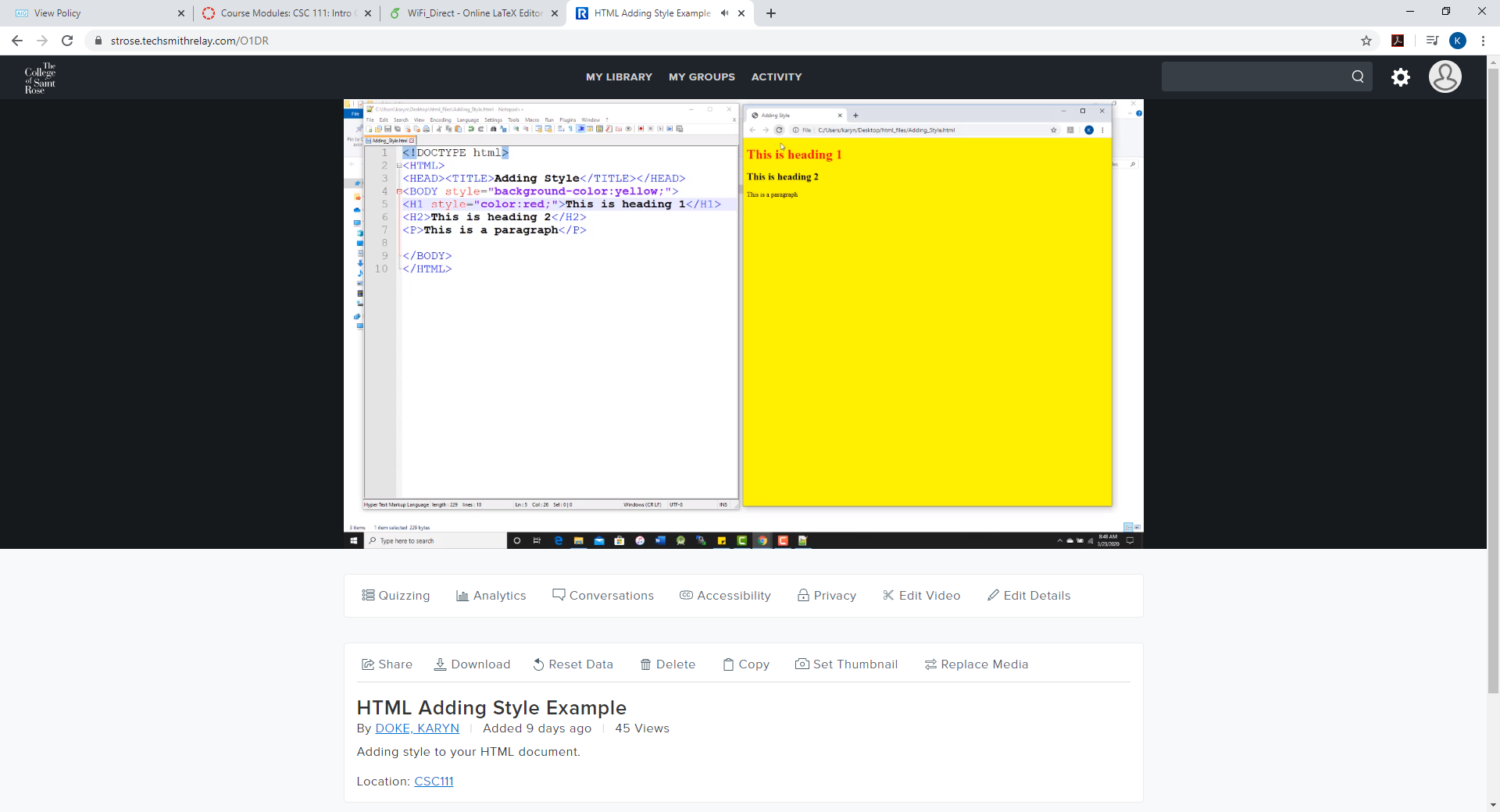 In addition, you can time the exams and include many questions: Students have to know the material to finish in the time allowed.
In addition, you can time the exams and include many questions: Students have to know the material to finish in the time allowed.
For the first year class CSC 111 I will probably give them an HTML project to do, like building a significant web page. For the other courses, I will have a timed exam.
Angela Gordon, business
I teach graduate and undergraduate managing effective teams. As you can imagine, both courses require team projects.
I was able to create a substitute for my undergrads, and I thought that my grad students would have completed most of the work on their projects. The assignment was to form teams and select two outside teams that they could observe. They would write a paper on the various aspects of team dynamics such as decision making, conflict, communication, and leadership. In past years, students have chosen Golden Knights sporting events, Albany Common Council meetings, and school board meetings to name a few. By the time we all moved online, I assumed that they had made their observations.
It turned out that the majority of the students had not observed teams yet and were looking for guidance. I decided to show “Twelve Angry Men,” the classic movie about a jury, to the class and offer this team as an alternative to observed teams they could no longer observe. Final papers are in, and I’m happy and relieved to report that all but one team wrote fantastic team analysis papers on “Twelve Angry Men.” The other team examined how different leadership teams reacted to COVID-19 for their organizations. I hadn’t planned on this topic, but the paper was outstanding!
Eyyub Kibis, business analytics
After the College moved to online course delivery, I started teaching my courses asynchronously. I always use TechSmith Relay to record the lectures and post them every week during the day of the course. I try to keep each recording short to keep students concentrated. Also, I embed quiz questions to the recordings about the course material in order to make sure that students are watching the recordings.
Students are required to work on group research projects in two of my three classes. I hold mandatory group meetings on Zoom every other week to discuss students’ progress on their projects, while also holding office hours on Zoom. The “Remote Control” option in Zoom helps me to remotely control students’ computers to see and fix problems in their codes during our Zoom meetings, which gives students a face-to-face office-hour feeling.
Ekaterina Midgette, literacy
Please see the instructions I created for a colleague on how to integrate Google Slides for group work on Zoom.
In three of my ECO classes, we have been studying how the shutdown of the economy has affected unemployment, and we have been following the data series Initial Claims for Unemployment Compensation (aka Jobless Claims) published by the Department of Labor. We call it the “hockey stick” because, on February 22, jobless claims were 211,00, and by March 21, they jumped to more than tenfold to 3,307,000 and doubled the next week to 6,648,000 on March 28. What will future weeks bring?
In my undergraduate curriculum class, we have been using the online classes as an opportunity to have some practicing teachers Zoom with us (see photo). Recently we had Kayla Curtiss Hastey ’15, G’17 show us how she is using technology with her third-graders to keep them engaged and learning through the pandemic. We had an opportunity to see technology and ask questions that we wouldn’t normally have been able to do.
Liz Richards, communications
I have had a couple of students submit audio projects that were really incredible, especially given that they didn’t have access to our editing equipment. And I’ve encouraged many of my students to use the pandemic as fodder for their creative work. Many have taken the charge, and I’m looking very forward to their creative take on COVID-19.
Barbara Ungar, English
I am using a combination of Canvas (more heavily Canvas for my lower level, lib-ed classes, since they are larger and not everyone has access to Zoom) and Zoom, which I am using more heavily in my upper-level English course, our senior seminar. That seminar is smaller so lends itself better to that format. We are focusing now on final papers, and I can give students individual feedback online, through Canvas or Google Docs, so that is what I am mostly doing now, till the end of the semester.
Grace Visher, math
I have primarily been making handouts with content, uploading them on Canvas under modules before the Zoom meeting for students to access, and then during the Zoom meeting, I share the handout via the Zoom screen for discussion.
I have also been using the discussion board where students are responding to a question on what they learn after the Zoom meeting discussion.
I am giving homework weekly, which they are submitting via Canvas.
Here are some examples of questions I put up for the discussion board:
— How did the week of virtual learning go for you? Are there areas you are still struggling in?
— What did you learn today? Post one key point or comment on someone else’s point.
— What did you learn today about fractions?
— What did you learn in today’s lesson on translation and reflection?
— How did last week go for you?
— Are you struggling in some areas?
— Please provide a little constructive feedback.
Some students have mentioned that it’s reassuring to meet during class time using Zoom, and that it’s helpful to have lecture notes beforehand. In addition, one suggested recording the Zoom sessions so that students can review the video later.
To submit homework, students are taking pictures of their work using their cell phone, converting it into a pdf for those who have special apps like Camscanner. Others have downloaded a Canvas app that allows them to upload pictures of their work directly on Canvas. Others are inserting pictures of their work in a Word document under Microsoft and uploading that as a file. If none of those methods works for any reason, I am having some students email me pictures of their homework.
I am majorly grading work through Canvas, and I am able to provide feedback as well.
Claire Ziamandanis, Spanish
I am mostly doing asynchronous work with students, but I do require they check in with me on Zoom once/week. I pose a “question of the week” in Spanish, and we chat about that, and about how things are going in general. It is more about personal connection with Zoom, not so much course content.
Tips from Karen Yancey at Online Learning
Here are some tips for transferring files to and from students.
Please note that The College of Saint Rose Online Learning Services YouTube channel has many video tutorials I created on how to upload to Relay, how to use screen capture, how to integrate it in Canvas and how to change ownership of a video. |



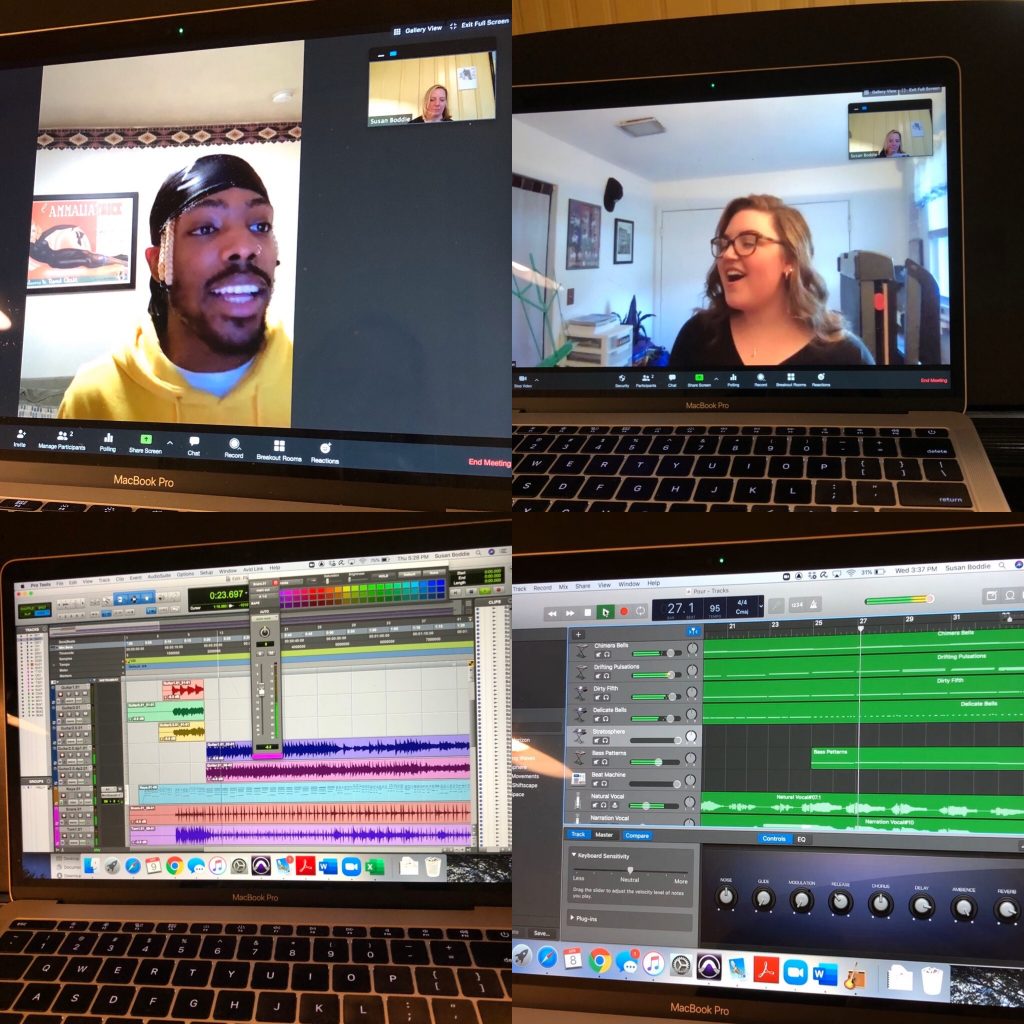
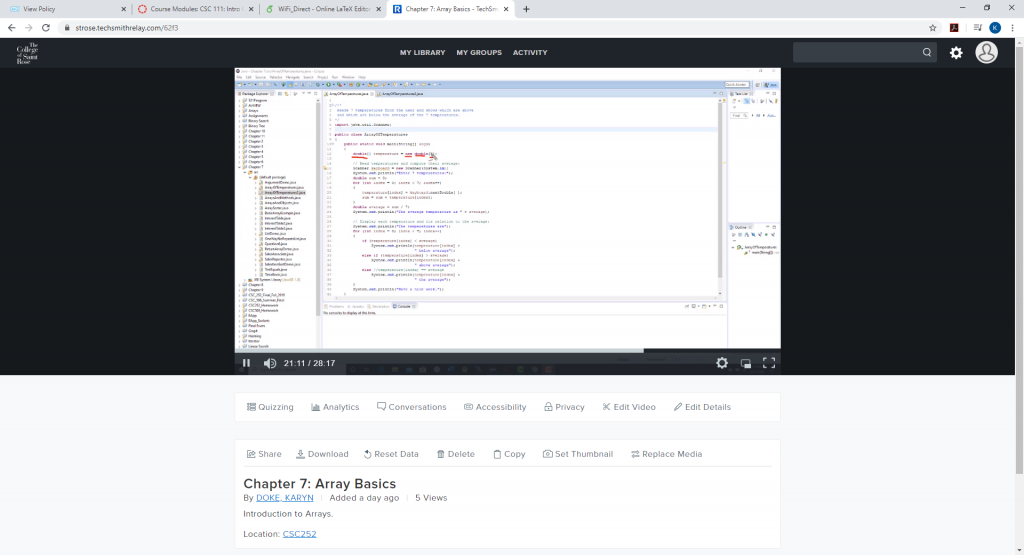

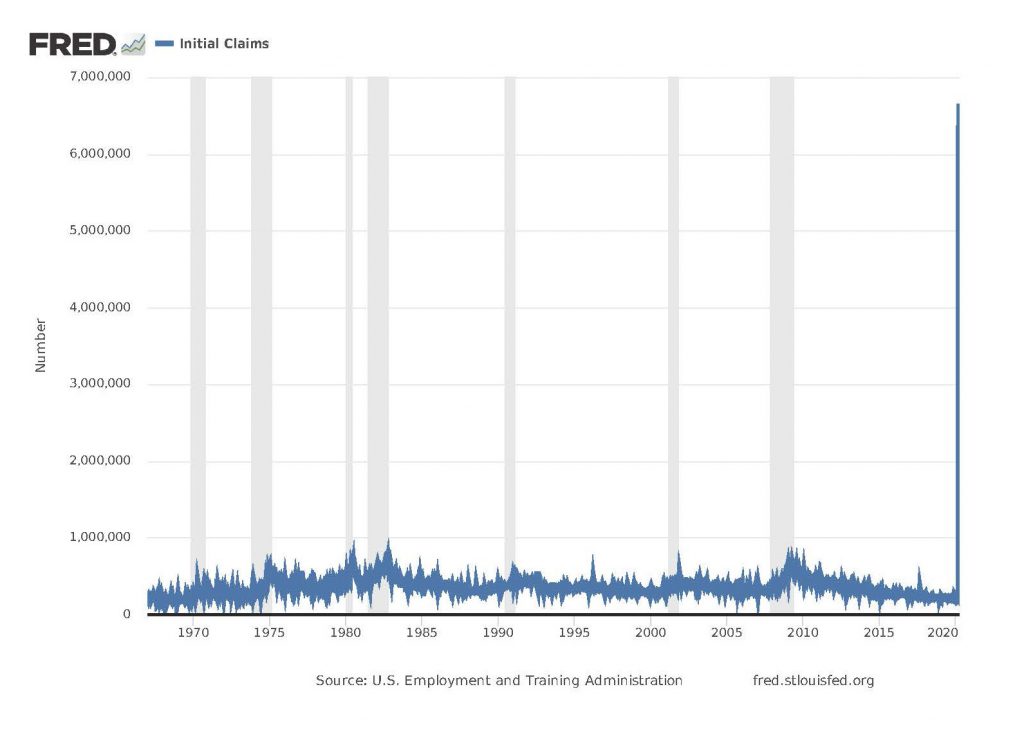
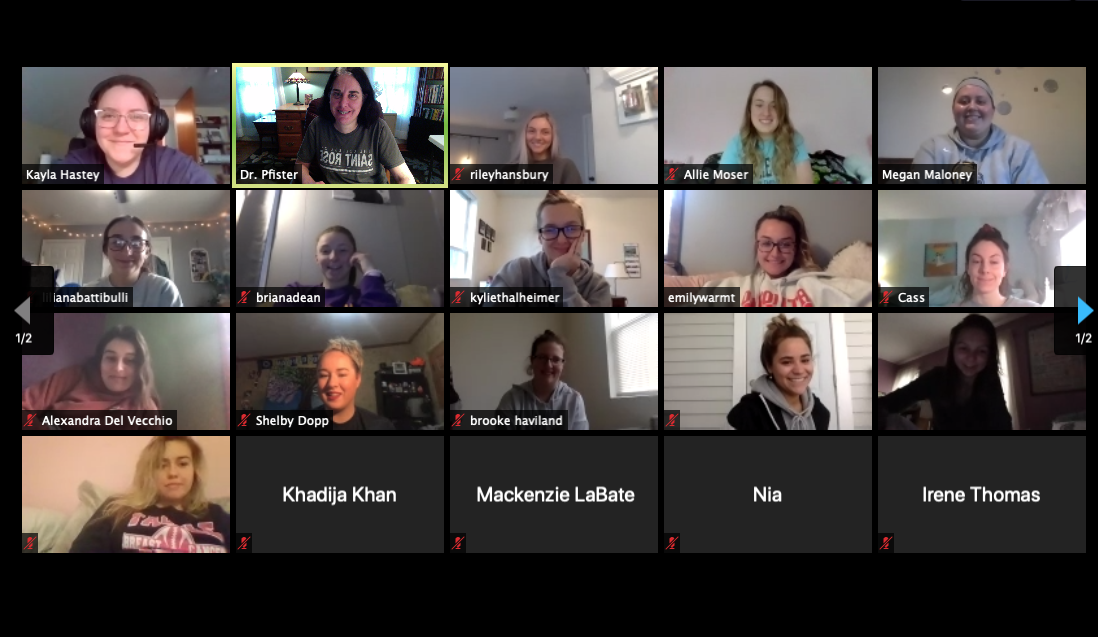
Comments posted on this site are held in moderation until approved by a site administrator. Vulgar, profane, obscene, offensive terms or personal attacks will not be tolerated.